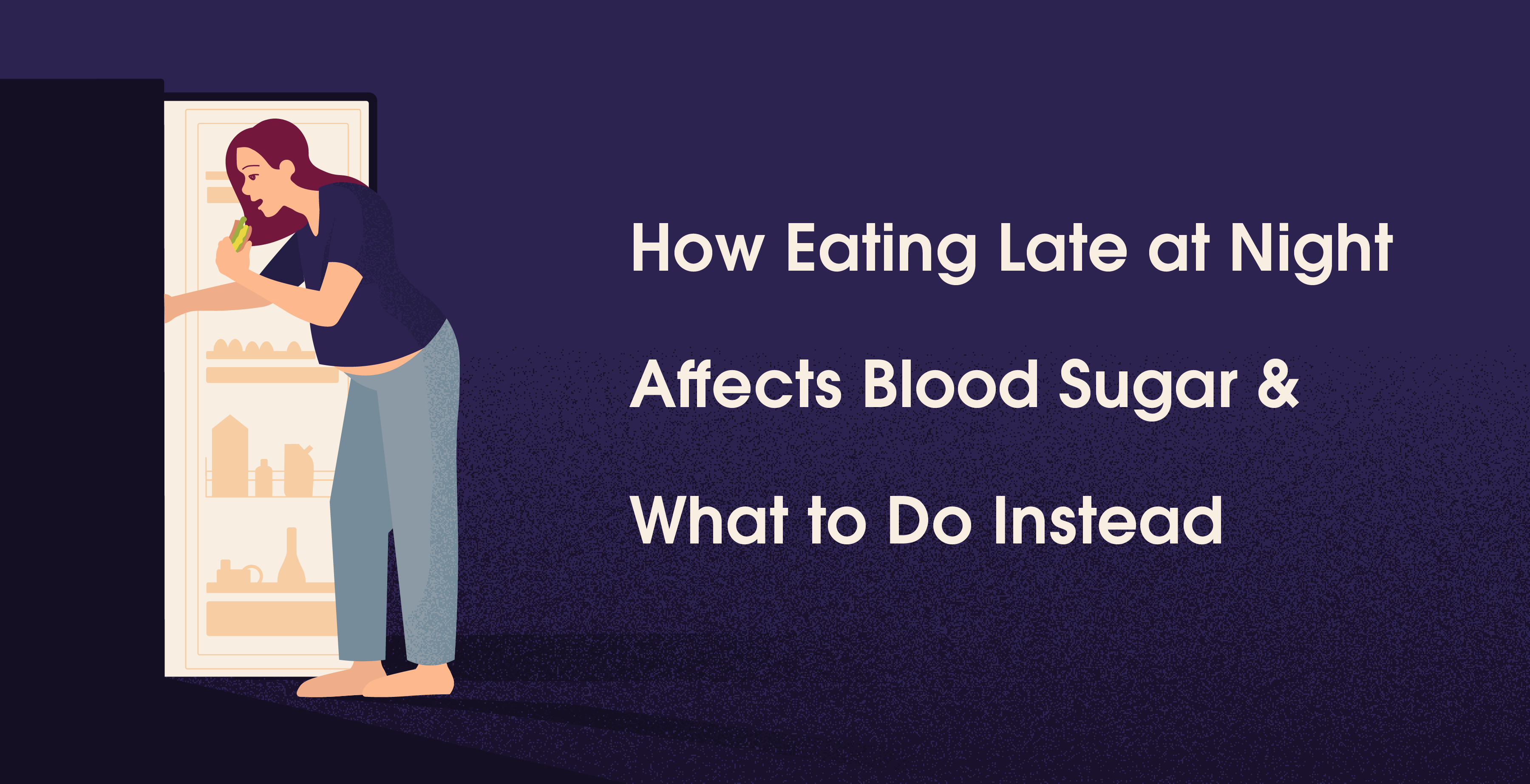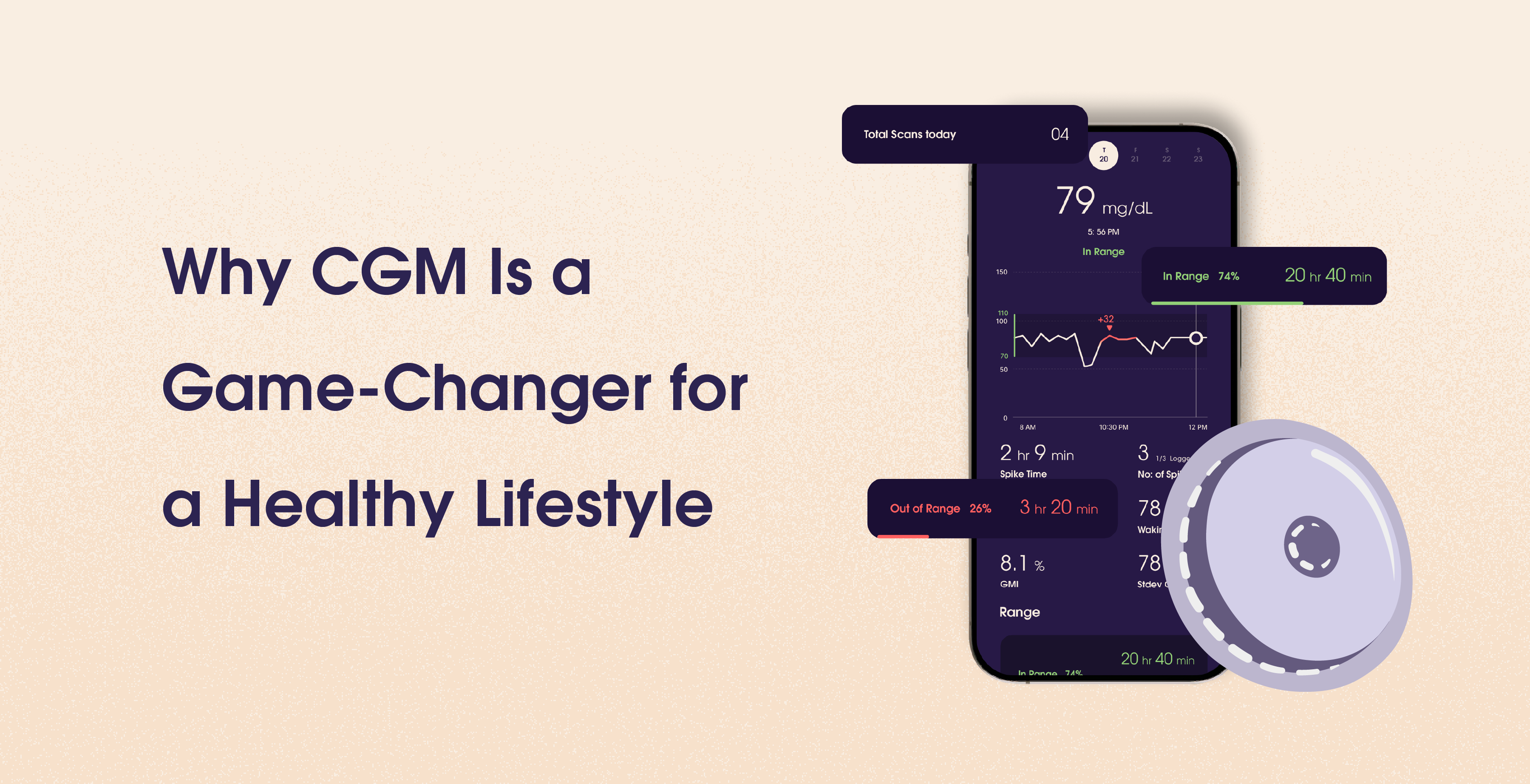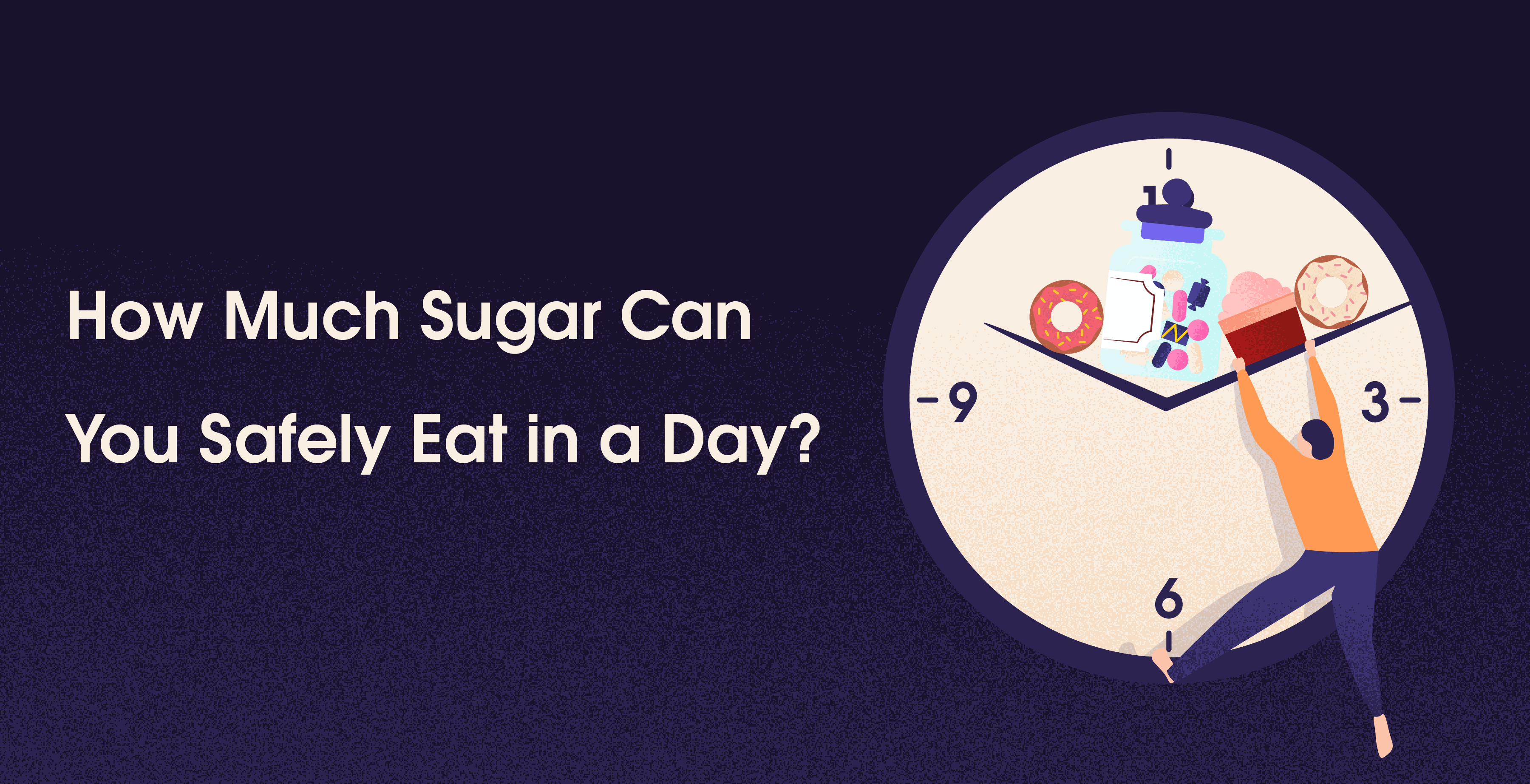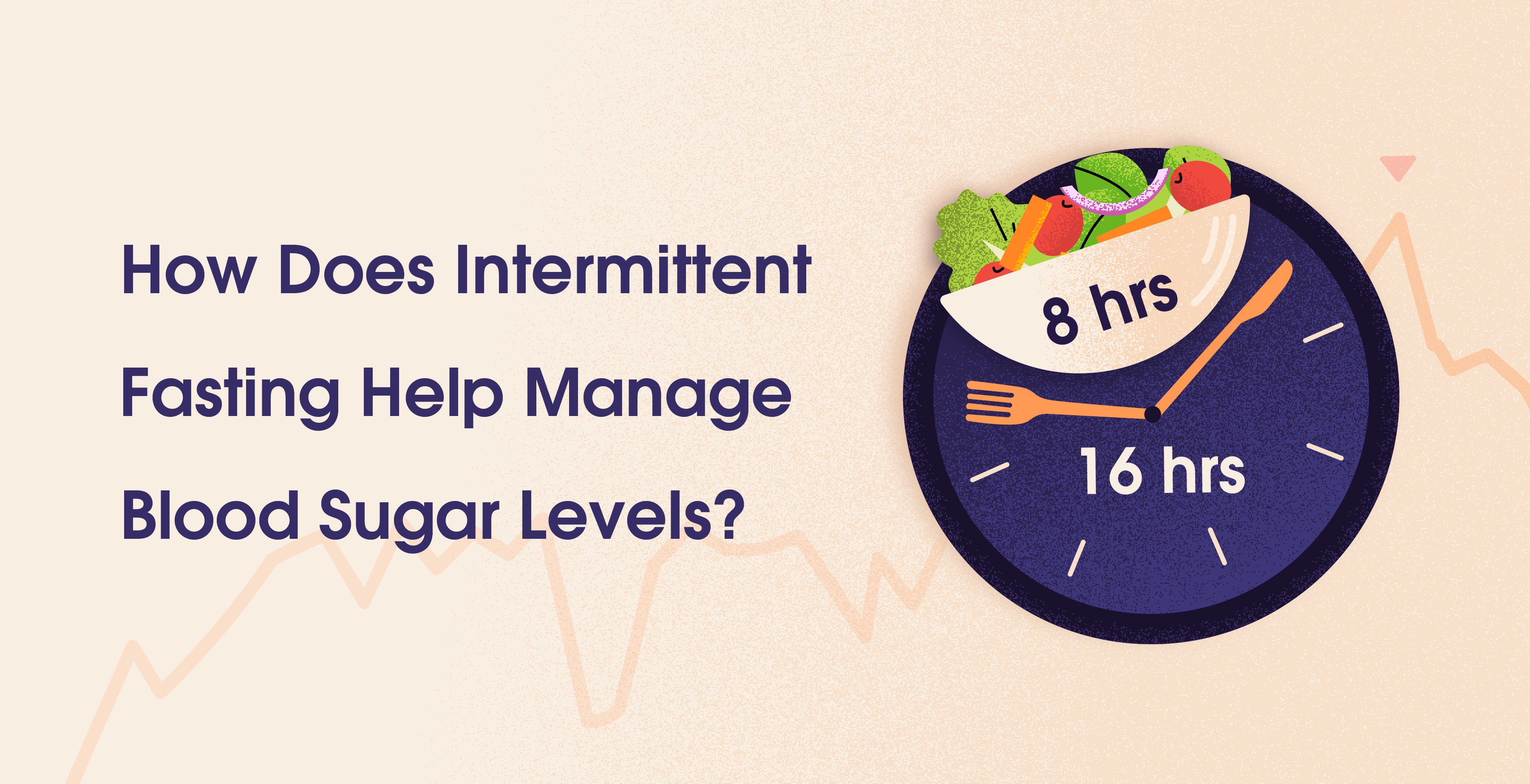Prediabetes Vs. Diabetes
Mar 7, 2024
Ashima Raizada



Table Of Contents
We've been seeing an increase in the number of people becoming prediabetic and diabetic over the last decade. But quite often, those struggling with symptoms of raised glucose levels don't even know it yet. In fact, 80% of the people who are prediabetic in America don't even know they have prediabetes. Plus, they can't tell whether they're prediabetic, diabetic or just insulin resistant. If you're one such person, you're in the right place! So let's start from the top.
What are Prediabetes and Diabetes?
Prediabetes and diabetes are conditions related to blood glucose control, influenced by the pancreas's role in managing blood glucose metabolism. When we eat, our pancreas produces insulin to convert food into glucose, meeting our energy needs. However, problems arise when the body either doesn't make enough insulin or resists its effects, leading to elevated blood glucose levels - a state known as diabetes. Diabetes is categorized into three main types:
Type 1 Diabetes: The body fails to produce insulin.
Type 2 Diabetes: The body cannot effectively use the insulin it makes.
Gestational Diabetes: This form occurs during pregnancy and typically resolves after birth.
Prediabetes is a precursor to diabetes, characterized by blood glucose levels that are higher than normal but not yet high enough to classify as diabetes. It's an early warning sign indicating that insulin function is beginning to impair, signaling the need for intervention to prevent the progression to full-blown diabetes
Signs and Risk Factors of Prediabetes and Diabetes
To begin with, let's focus first on signals of prediabetes and diabetes. Prediabetes and diabetes can be sneaky, often flying under the radar without noticeable symptoms for years. However, there are times when your body waves a few red flags, including:
Blurry vision
An unquenchable thirst
The need to pee more often
Dry mouth and cracked lips
Getting infections more often
Slow healing of cuts and wounds
A tingly or numb feeling in your hands or feet
Feeling more irritable or anxious than usual
Constant tiredness
So, how can you tell if you're more at risk for prediabetes or diabetes? The CDC points to two major factors: carrying extra weight and being over the age of 45. (1) Both are closely tied to your body's ability to use insulin properly.
But that's not all. Other common risk factors that could up your chances include:
A family history of diabetes
An unhealthy lifestyle
Having had diabetes while pregnant (known as gestational diabetes)
Existing chronic conditions, especially those related to heart health
Keeping an eye on these factors can help you gauge your risk and take steps to manage it.
Prediabetes v/s Diabetes
If you're trying to distinguish between prediabetes and diabetes, here's a straightforward explanation. Diabetes occurs when your blood glucose levels are consistently high, exceeding the normal range. On the other hand, prediabetes is a condition where your blood glucose levels are elevated but not high enough to be classified as diabetes.
According to the American Diabetes Association, a normal fasting blood glucose level is below 100 mg/dL. (2) You're considered diabetic if your fasting glucose level is above 126 mg/dL. If your results are between 100 mg/dL and 125 mg/dL, you fall into the prediabetes category.
Prediabetes often doesn't show clear symptoms, making it hard to detect without testing. However, early diagnosis can allow for lifestyle changes and medication that may return blood glucose levels to normal, preventing the progression of diabetes.
How to Tell if You're Prediabetic or Diabetic?
So now, let's connect the dots between your body signals and diagnostic tests for your overall well-being.
The diagnosis of prediabetes and diabetes is based on specific laboratory findings. The relevant tests to measure your blood sugar level are:
Glycosylated Haemoglobin Assay- This test detects your blood glucose over the 60 to 90 days before the collection of blood samples. It is one of the recommended tests for the definitive diagnosis of diabetes and prediabetes.
Fasting Plasma Glucose Test- This test measures your blood glucose levels after fasting for at least 8 hours. According to ADA, if the glucose level falls between 110-126 mg/dL, it indicates prediabetes, and if your level is above 126 mg/dL, it is considered diabetes mellitus.
Random Plasma Glucose Test- This test measures sugar levels at any moment, any time of the day. It doesn't matter whether you are fasting or not, it's a random check of your glucose.
How are Prediabetes and Diabetes Treated?
For both diabetes and prediabetes lifestyle modifications emphasizing your diet, exercise, sleep, and weight control are the mainstays. Along with this, if you ask us, we recommend educating yourself either through a diabetes educator, an app or a health coach.
So here are some pointers to change your nutrition to help you fight against prediabetes and optimize your glucose level:
Eat a fibre-rich diet- Include nutrient-dense, whole foods and fiber-rich food like fruit and vegetables in your diet. These fiber-rich foods are low in glycemic index and reduce the sugar level in your body. (3)
Eat food in the right order- Along with eating the right food, the right order also helps you manage your sugar level. So make sure to eat fibres and proteins first and then your carbs, it will delay glucose absorption in the body.
Drink lots of water- Water helps flush out extra glucose from the body, thus keeping your sugar level in check. So stay well-hydrated.
Practice Intermittent fasting- Intermittent fasting is all about eating patterns. Hence, keep your eating window approximately 4-10 hours and extend the overnight fasting.
Avoid counting calories - It is overwhelming to keep an eye on each calorie intake. So, eat a low-carb diet while cutting your portion sizes at meals to improve blood glucose and insulin resistance.
Additionally, the American Diabetes Association recommends daily exercise can prevent or delay initiation of Type 2 Diabetes. (4) They suggest that both aerobic and resistance exercises are necessary in the treatment of prediabetes. The association also adds the perks of breaking a sedentary lifestyle by indulging in light physical activity 30 minutes after prolonged sitting.
Apart from these modifications, the last resort in the treatment of prediabetes and diabetes is the use of oral hypoglycemic drugs such as Metformin, Rosiglitazone, etc, which have been used for years to manage hyperglycemia. You can learn more about the treatment of prediabetes and diabetes on our blog Prediabetes Treatments: Everything You Need To Know.
Can Prediabetes be Reversed?
Do you fear your prediabetes can never be reversed? Don't worry, with early detection of prediabetes and making healthy lifestyle choices in your diet and exercise, you can reverse prediabetes.
The Centre for Disease Control clearly states that a diagnosis of prediabetes is your chance to avoid diabetes. However, they also mention that if prediabetic people do not take preventive measures, then they could be arrested by the devastating Diabetes within five years of diagnosis.
Moreover, The Diabetes Prevention Program(DPP) initiated by the National Institute of Diabetes and Digestive and Kidney Disease(NIDDK) emphasizes the role of weight loss through dietary modifications and physical activities in reversing the Prediabetes condition. (5) Another important step is the management of stress. You can learn more about reversing prediabetes naturally here.
Remember, like anything in life, patience and dedication are the keys to reversing prediabetes.
The Final Words
Differentiating between prediabetes and diabetes is important to understand to take action for a healthy life. Diagnostic tests like HbA1C, fasting glucose test, and random glucose tests guided individuals to tailor the required interventions in the management of prediabetes and diabetes. Both prediabetes and diabetes require a full-on treatment.
Prediabetes is a subtle warning urging us to pay attention to the body's signals before the onset of diabetes. When we recognize the silent symptoms of prediabetes, such as excessive thirst, blurred vision, and frequent infections it allows us to take matters into our own hands to subtly decrease the chance of diabetes. Here, armed with knowledge, awareness, and a commitment to a healthier lifestyle, you can navigate your health journey.
References
We've been seeing an increase in the number of people becoming prediabetic and diabetic over the last decade. But quite often, those struggling with symptoms of raised glucose levels don't even know it yet. In fact, 80% of the people who are prediabetic in America don't even know they have prediabetes. Plus, they can't tell whether they're prediabetic, diabetic or just insulin resistant. If you're one such person, you're in the right place! So let's start from the top.
What are Prediabetes and Diabetes?
Prediabetes and diabetes are conditions related to blood glucose control, influenced by the pancreas's role in managing blood glucose metabolism. When we eat, our pancreas produces insulin to convert food into glucose, meeting our energy needs. However, problems arise when the body either doesn't make enough insulin or resists its effects, leading to elevated blood glucose levels - a state known as diabetes. Diabetes is categorized into three main types:
Type 1 Diabetes: The body fails to produce insulin.
Type 2 Diabetes: The body cannot effectively use the insulin it makes.
Gestational Diabetes: This form occurs during pregnancy and typically resolves after birth.
Prediabetes is a precursor to diabetes, characterized by blood glucose levels that are higher than normal but not yet high enough to classify as diabetes. It's an early warning sign indicating that insulin function is beginning to impair, signaling the need for intervention to prevent the progression to full-blown diabetes
Signs and Risk Factors of Prediabetes and Diabetes
To begin with, let's focus first on signals of prediabetes and diabetes. Prediabetes and diabetes can be sneaky, often flying under the radar without noticeable symptoms for years. However, there are times when your body waves a few red flags, including:
Blurry vision
An unquenchable thirst
The need to pee more often
Dry mouth and cracked lips
Getting infections more often
Slow healing of cuts and wounds
A tingly or numb feeling in your hands or feet
Feeling more irritable or anxious than usual
Constant tiredness
So, how can you tell if you're more at risk for prediabetes or diabetes? The CDC points to two major factors: carrying extra weight and being over the age of 45. (1) Both are closely tied to your body's ability to use insulin properly.
But that's not all. Other common risk factors that could up your chances include:
A family history of diabetes
An unhealthy lifestyle
Having had diabetes while pregnant (known as gestational diabetes)
Existing chronic conditions, especially those related to heart health
Keeping an eye on these factors can help you gauge your risk and take steps to manage it.
Prediabetes v/s Diabetes
If you're trying to distinguish between prediabetes and diabetes, here's a straightforward explanation. Diabetes occurs when your blood glucose levels are consistently high, exceeding the normal range. On the other hand, prediabetes is a condition where your blood glucose levels are elevated but not high enough to be classified as diabetes.
According to the American Diabetes Association, a normal fasting blood glucose level is below 100 mg/dL. (2) You're considered diabetic if your fasting glucose level is above 126 mg/dL. If your results are between 100 mg/dL and 125 mg/dL, you fall into the prediabetes category.
Prediabetes often doesn't show clear symptoms, making it hard to detect without testing. However, early diagnosis can allow for lifestyle changes and medication that may return blood glucose levels to normal, preventing the progression of diabetes.
How to Tell if You're Prediabetic or Diabetic?
So now, let's connect the dots between your body signals and diagnostic tests for your overall well-being.
The diagnosis of prediabetes and diabetes is based on specific laboratory findings. The relevant tests to measure your blood sugar level are:
Glycosylated Haemoglobin Assay- This test detects your blood glucose over the 60 to 90 days before the collection of blood samples. It is one of the recommended tests for the definitive diagnosis of diabetes and prediabetes.
Fasting Plasma Glucose Test- This test measures your blood glucose levels after fasting for at least 8 hours. According to ADA, if the glucose level falls between 110-126 mg/dL, it indicates prediabetes, and if your level is above 126 mg/dL, it is considered diabetes mellitus.
Random Plasma Glucose Test- This test measures sugar levels at any moment, any time of the day. It doesn't matter whether you are fasting or not, it's a random check of your glucose.
How are Prediabetes and Diabetes Treated?
For both diabetes and prediabetes lifestyle modifications emphasizing your diet, exercise, sleep, and weight control are the mainstays. Along with this, if you ask us, we recommend educating yourself either through a diabetes educator, an app or a health coach.
So here are some pointers to change your nutrition to help you fight against prediabetes and optimize your glucose level:
Eat a fibre-rich diet- Include nutrient-dense, whole foods and fiber-rich food like fruit and vegetables in your diet. These fiber-rich foods are low in glycemic index and reduce the sugar level in your body. (3)
Eat food in the right order- Along with eating the right food, the right order also helps you manage your sugar level. So make sure to eat fibres and proteins first and then your carbs, it will delay glucose absorption in the body.
Drink lots of water- Water helps flush out extra glucose from the body, thus keeping your sugar level in check. So stay well-hydrated.
Practice Intermittent fasting- Intermittent fasting is all about eating patterns. Hence, keep your eating window approximately 4-10 hours and extend the overnight fasting.
Avoid counting calories - It is overwhelming to keep an eye on each calorie intake. So, eat a low-carb diet while cutting your portion sizes at meals to improve blood glucose and insulin resistance.
Additionally, the American Diabetes Association recommends daily exercise can prevent or delay initiation of Type 2 Diabetes. (4) They suggest that both aerobic and resistance exercises are necessary in the treatment of prediabetes. The association also adds the perks of breaking a sedentary lifestyle by indulging in light physical activity 30 minutes after prolonged sitting.
Apart from these modifications, the last resort in the treatment of prediabetes and diabetes is the use of oral hypoglycemic drugs such as Metformin, Rosiglitazone, etc, which have been used for years to manage hyperglycemia. You can learn more about the treatment of prediabetes and diabetes on our blog Prediabetes Treatments: Everything You Need To Know.
Can Prediabetes be Reversed?
Do you fear your prediabetes can never be reversed? Don't worry, with early detection of prediabetes and making healthy lifestyle choices in your diet and exercise, you can reverse prediabetes.
The Centre for Disease Control clearly states that a diagnosis of prediabetes is your chance to avoid diabetes. However, they also mention that if prediabetic people do not take preventive measures, then they could be arrested by the devastating Diabetes within five years of diagnosis.
Moreover, The Diabetes Prevention Program(DPP) initiated by the National Institute of Diabetes and Digestive and Kidney Disease(NIDDK) emphasizes the role of weight loss through dietary modifications and physical activities in reversing the Prediabetes condition. (5) Another important step is the management of stress. You can learn more about reversing prediabetes naturally here.
Remember, like anything in life, patience and dedication are the keys to reversing prediabetes.
The Final Words
Differentiating between prediabetes and diabetes is important to understand to take action for a healthy life. Diagnostic tests like HbA1C, fasting glucose test, and random glucose tests guided individuals to tailor the required interventions in the management of prediabetes and diabetes. Both prediabetes and diabetes require a full-on treatment.
Prediabetes is a subtle warning urging us to pay attention to the body's signals before the onset of diabetes. When we recognize the silent symptoms of prediabetes, such as excessive thirst, blurred vision, and frequent infections it allows us to take matters into our own hands to subtly decrease the chance of diabetes. Here, armed with knowledge, awareness, and a commitment to a healthier lifestyle, you can navigate your health journey.
References
Table Of Contents
Table Of Contents
Table Of Contents
Read More


Mar 25, 2025
Sayfali Rawlani


Mar 20, 2025
Sayfali Rawlani


Mar 6, 2025
Sayfali Rawlani



Company
Copyright © 2025 trst health. All right reserved.

